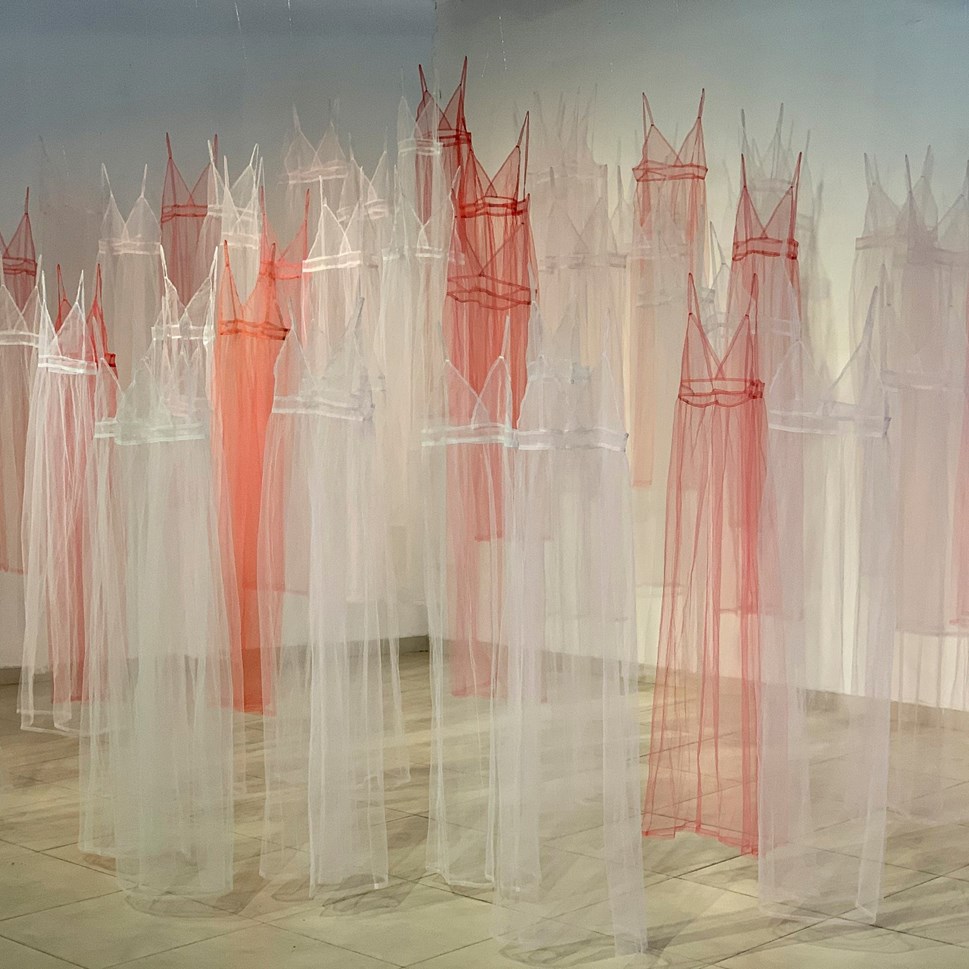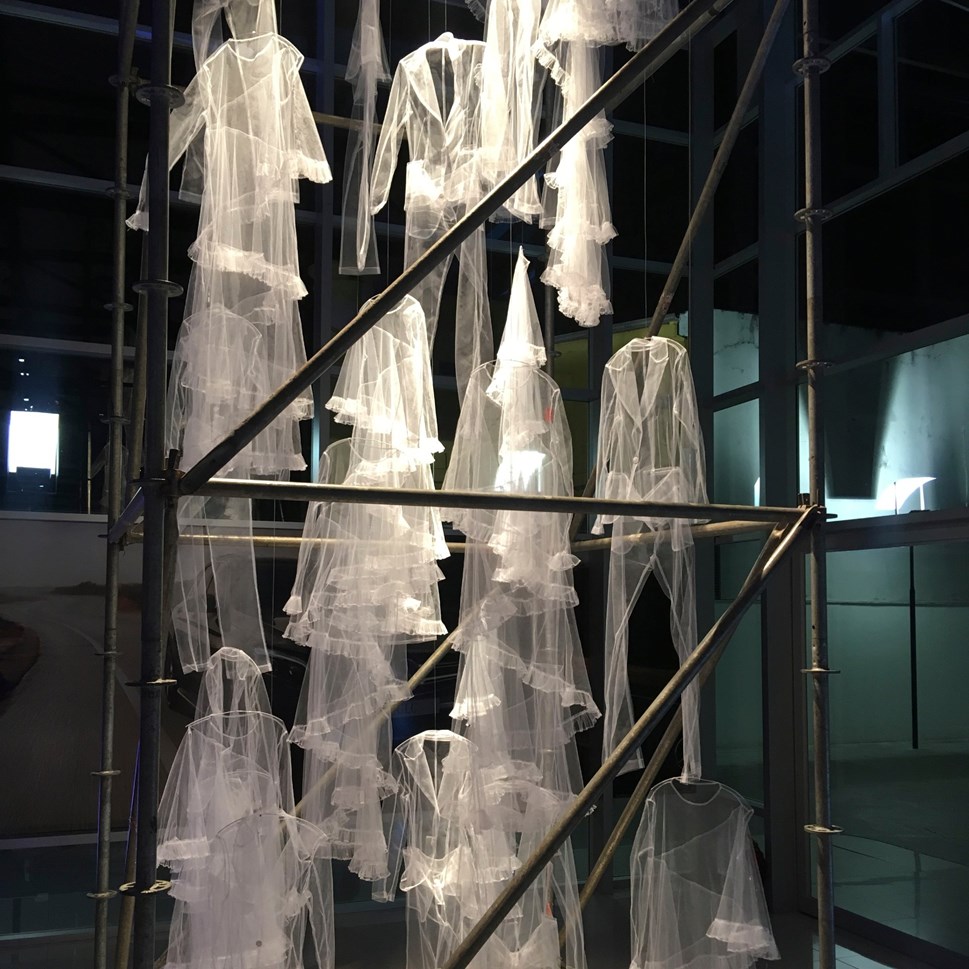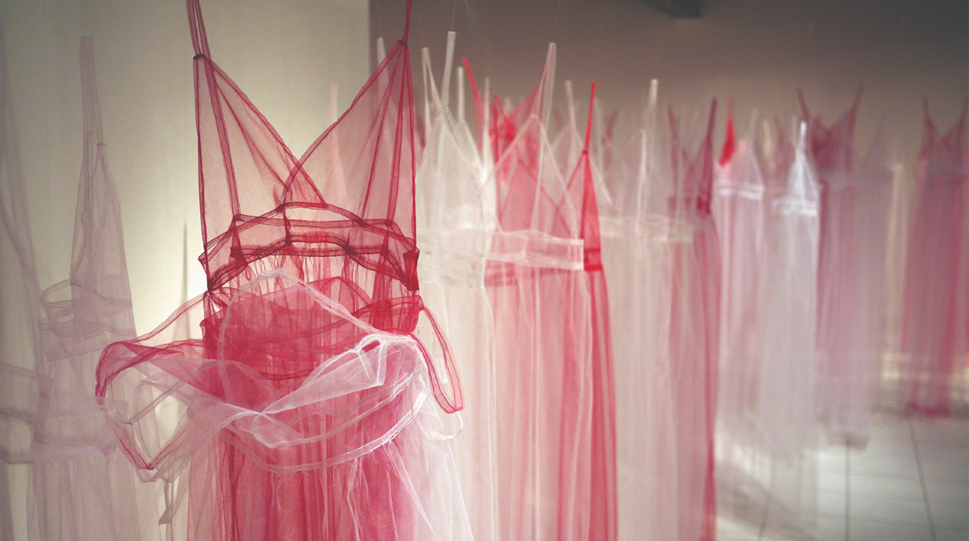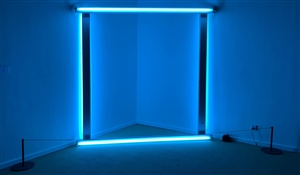Interview With Claudia Casarino; The Creator of Textile Works to Combat Discrimination and Stereotypes
21 Aug 2022Marzieh Eslami conducted this interview with Claudia Casarino. Throughout her works, Paraguayan artist Claudia Casarino condemns stereotypes that have imposed pressure on people, particularly women, for many years. Casarino's works reflect her sensitivity and empathy, and as an artist, she obstinately intends on improving the world into a better place through her work. With photographs, films, installations, and hidden concepts within her works, she reveals her strong convictions.
- I'm really thankful and happy to have this conversation with you. If I try to explain to you how did I meet your artworks that goes back to 6 years ago when I started my fashion courses and I used to surfing on internet in order to find some sources of inspiration for my collection. I saw one of your installations (Uniform) on Pinterest. I kept searching to find the artist and that led me to you. One the most interesting things that made me feel a closer relationship with your artworks was that you weren't European. I thought that these artworks were made by an approach to the world which is closer to mine than a European.

A view of "Uniform" installation | Source: www.claudiacasarino.com
-You're going to make me cry.
I always tend to speak about the other woman. The non-white European woman. That's what I tried to do. I tend to speak to them instead of the hegemonic white colonialist system. And I'm so glad you read them. I come from a very very little country in the center of South America where landlocked and quite isolated. It's quite odd for a Paraguayan artist. I've exhibited in Algeria, Bahrain, and Jordan at the national gallery. It's not very common for a South American artist to be shown in these places. I think in the art world the connections must be through Europe or New York. It's very hard to knit connections with other parts of the world. Everything is mediated. It's very difficult.
- Exactly. As the first question, I want to ask you to tell me about your journey in art world. How did you start and explain more about your background please.
-I started a bit late. I was 22 when I started art school. I used to be a professional squash player for Paraguay. The art school didn't start in Paraguay as a university career until 1996. I started art school in 1996. I belong to the first group that studied art professionally in Paraguay. I didn't want to be an artist I wanted to be an art historian. But a newspaper launched a contest for young artists. And the prize was a trip to Ecuador to see a biennial. I was really surprised when I won the contest because I wasn't an artist and it was my first semester at school. So I went to Ecuador and that was my first experience as an artist. My mother moved to New York so I started traveling back and forth to New York which was fundamental for my studies. I started taking courses at school of visual arts in New York. Then I started working as an assistant teacher in primary school in Brooklyn with immigrant children from Mexico. The fundamental axis of my work had to do with violence. The visible and naturalized violence. The visible violence had to do with borders, extractivism and slavery. and the naturalized has to do with assigned gender roles, beauty and things like that are not seen as violence but actually are. I was really privileged because I could study, I could travel, I could do anything that I wanted. I had a family which allowed me do everything. And also other things which is not seen as privilege but they are. For example for South America I am considered as a white woman. I have to assume my privileges. I'm a cisgender heterosexual woman. I'm married and I have kids. They are not things that I've never chosen but those things make you privileged. I don't say my career was easy because it wasn't, but it was less difficult than for other women. Because of my mother, I had the privilege to go to New York and see all the art history they have stolen from all over the world (laughing). My story and journey can be read as a privileged woman but of course it's not as easy as it seems.
- As the other question I want to ask you about the specific material, forms and shapes you choose for your installations. Most of them are fabrics and clothes. Why and how did you choose them?

A view of "Visible/ Unvisible" installation | Source: www.claudiacasarino.com
-It is quite important for me not to be considered as a textile artist. I consider myself as a political and conceptual artist. For me, some specific fabrics are what involved with the politics of appearance. It's not about fashion but the politics of appearance. I work with tulle material a lot. Because tulle for southern post-colonial women like in Paraguay and South America is used in rites of passages. White tulle always represents purity. You use it when you get married and you use it when you turn into 15 years old and you like to dress like a princess. It is used in some other catholic rites. And also black tulle presents in the rites of mourning; for example widowers have to have this black tulle covering their faces. That's why I constantly use tulle because it's about women through the history. And another material which I use is cotton. I use it when I want to talk about colonialism and extractivism. Because cotton is the fundamental rock of capitalism. When their exploitation of cotton started in my continent it was strictly related to slavery, human trafficking, violence and women's body. Because when the owner of the land buys you as a slave, you will not only work for him, he is the owner of your life and can even rape you in order to have more slaves. It was one of the main income which women can access to. The history of Paraguay is founded on rape basically. (20:52) because in the 16th century when the Spanish people came to Paraguay, some of the local indigenous people had this way of doing politics that involved the women's body. We wanted to make an agreement with other tribes; we give you women and we make a parenthood. They gave women to the Spanish or the Spanish raped women. The children created this way and so we are all basically the children of rape.
- You've already answered one of my next questions. So you don't consider yourself as a conceptual fashion designer?
-No. Even though I've worked with fashion designers. At first, I was a fashion editor for some magazines and I was a fashion stylist. And I also worked with many fashion brands here as an advisor. I've studied fashion in order to be able to talk because when we talk about women, the fashion and the politics of appearance is very important. Our bodies are constantly covered by ideologies that are fashion. Fashion is just like walking market propaganda. At least for us! I don't want to be universal because there is nothing universal! Only violence.
- So your cultural and geographical background affects you a lot. Now what kinds of obsessions do you have as an artist? Global? Local? Or a combination of both?
-The thing is I don't believe there is something as global, there are so many diversity and I have to respect that. I can only speak about what I know and that's why I speak about my experience and my family experience. I can't talk on top of other women. I will never ever even try to talk about indigenous women because I'm not indigenous. And if you read about them you only read the white person's view of indigenous women. There are no books about indigenous people and history in Paraguay written by indigenous authors. Even though my work is situated here, I can recognize common things with other realities. But I cannot say I'm speaking for all women.
- You mentioned the materials of your artworks and I want to ask you about the form. You always use shirts and gowns in your works. How did you choose these two kinds of clothes?

A view of "Sleep Disorders" installation
-Shirts are presented neutral for western countries. White shirts are presented as the neutral garment. Women and men use shirts and it's also a uniform for work. I used it since 1999 in my first solo exhibition and I started to talk about binarism in gender and I started to question it. For my first exhibition I tried to erase gender from my body. I shaved my head and I went on fasting to erase my boobs and bum so I was quite thin. I became 47 kilos and questioned about gender. Where is gender? It's not on the body, it's somewhere else. That was like a silent performance. In the 90s the general talk in art was about the body and the presentation of the body. Especially influenced by artists like Cindy Sherman. She had a huge influence on my work. And when I use gown, they are very specific. For sleeping disorder I used nightgowns because I was talking about human trafficking. When you dream about a better horizon and you end up in human trafficking chains. It's very common in Paraguay for girls. They think they're going to work in other countries and then they trap in human trafficking chains. That's why the gowns are white and they turn into red. In that installation there are white, light pink, dark pink and red. ...so I used very specific pieces and everything has meaning; nothing is arbitrary. I try to take off the pills of onion. I want to speak with minimum. You know, art is very elitist. And the main audience has to be trained to translate our work. To make this path shorter, I tried to make many beautiful things that attract the gaze. I always go to clothing and simple things to shorten the path of understanding. That's why I try to use everyday objects to talk so the audience will feel closer. Some curators ask me how can you make something beautiful when you're talking about something so horrible? I think beauty has privileges that make your gaze easier than if you make something ugly. What's the point of making something ugly when you want to talk about something ugly? I think I will attract more views if I make something beautiful to make you turn your head and start seeing what I'm trying to say.
- Most of your works have a mood of pendency and they are suspended. What do you want to tell us with this kind of installations?
-There are so many things into that. Some of them are the women who they are always the subject of the case. We are always being judged. Our bodies are always being judged. We are always the center of the gaze as if we were not being able to move, like we are there still and everybody is gazing. For uniform, I wanted to talk about the people who work for us and we treat them like they are completely invisible. In those uniforms your gaze can go through those bodies which they are hanging there for you but they are invisible. That piece is very self-explanatory and it was based on the experience of my aunt working for a woman in Spain. But I try to use simple things that will mean something to somebody that doesn't know the things I know. And even doesn't need to know the story of my aunt to be appealed by the black uniforms
-
After Uniform, another installation which spreads on web a lot was "Tanta Intemperie". Can you please explain more about it? What was the main idea?
-It means outdoor, not having the roof. And for me it equals to be unprotected. There was a very important author in Paraguay his name is Rafael Barrett. He wrote a book that is very important for us and its name is "The Paraguayan Pain". In this book he talks a lot about matte fields where people were being treated as slaves. I was investigating about matte fields and I found a photo reporter from Argentina and one of the photos caught my eyes. It was a man who was wearing his shirt backwards leaving his back naked to carry the matte leaves. And I also read about that was happening in the 20th century. They were rather use their shirts backwards and hurt their skin because they will never be able to buy another shirt. And they slept in the field under the stars with no roof and there was also the lack of protection against every kinds of dangers. All of these are just to consume these people in the morning. So in this installation I made shirts with no backs. The minimum amount of leaves was 50 kilos and they were paid by weight. If it was less than 50 kilos they would pay nothing. I made a chain of backless shirts which were very tiny.

A view of "Undressed" installation | Source: www.claudiacasarino.com
-
And the last question. There are some of your installations which I want to know more about them. I want ask you to explain about these works and their concepts:
The Island (la isla), We The Others (Nosotros Los Otros), Double Unfold.
-The island is about the isolation of power. The power chair is a poster by the shirts of powerful men. And its reflection in the mirror shows they can only see themselves. Nosotros Los Otros is we, the other. We are always the others to somebody else. And what's the other? The other is the thing that you cannot grasp and scares you. Even though I'm a white person in Paraguay, when I go to Germany, I'm the other. Or if I go to England I'm the other. If I go to Brazil, I'm the other. Even if I present myself to a homosexual person I'm the other. Even though we believe we are the center but we are always the other. I used many colors here because the other is always different. You know I'm not a painter I'm not a drawer. I don't create things from zero. I work with the pre-existent so I try to control the meaning of everything that I use.
Double Unfold is about assigned gender roles. As women we have to unfold ourselves constantly to fill all the assigned gender roles. The pleats hide and when you unfold you develop something. It's the process of folding and unfolding in order to be the woman that the world is waiting to see. You have to unfold yourself in many different roles.
Cover and slider images:
- www.claudiacasarino.com






